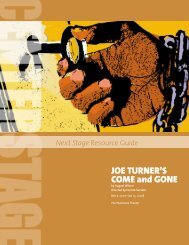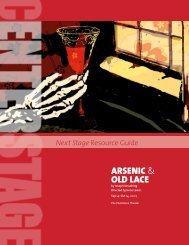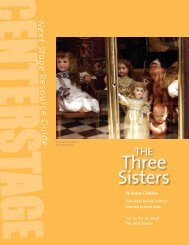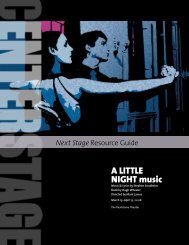The Matchmaker - Center Stage
The Matchmaker - Center Stage
The Matchmaker - Center Stage
Create successful ePaper yourself
Turn your PDF publications into a flip-book with our unique Google optimized e-Paper software.
Glossary<br />
continued<br />
Fifth Avenue Hotel<br />
<strong>The</strong> Fifth Avenue Hotel, at Madison Square (the intersection of<br />
Broadway and Fifth Avenue at 23 rd Street), stood at the center<br />
of New York City’s cultural life in the latter half of the 19th<br />
century. Built by architect Amos Eno, the massive luxury hotel<br />
was initially known as “Eno’s Folly,” since it lay far uptown of<br />
Manhattan’s initial hotel district. It was also known as “the<br />
vertical railroad” for its size: it was the first hotel in New<br />
York City with elevators, (originally steam-operated), every<br />
room had a fireplace and bathroom, and public ballrooms<br />
hosted many high-society events. Holding up to 800 guests,<br />
the Fifth Avenue Hotel was at least partially responsible<br />
for the development of northern Manhattan, joined in the<br />
area by the Brunswick, the Victoria, the Hoffman House, the<br />
Madison Square <strong>The</strong>ater, and many private clubs. Perhaps<br />
most importantly, the Fifth Avenue Hotel was the face of<br />
nouveau riche America in the 1870s, “the temporary abode<br />
of the ‘petroleum’ and ‘shoddy’ aristocracy – rough, illiterate,<br />
vulgar creatures for the most part, who claim preeminence on<br />
the score of their money bags.” <strong>The</strong> Flatiron Building (1908)<br />
and Met-Life Tower (1909), monuments of the skyscraper era<br />
shortly to come, still stand nearby.<br />
Fifty cents<br />
<strong>The</strong> average annual wage for manufacturing workers in 1900<br />
was only $435, or $8.37 a week. Unskilled workers were paid ten<br />
cents an hour on the average, about $5.50 a week. Fifty cents<br />
was an astronomical price for a haircut, the equivalent of four<br />
hours of work, or around 40 dollars in current estimation. A<br />
much more common unit of currency was the nickel, which<br />
could purchase a meal, a streetcar ticket, or an amusement<br />
park ride.<br />
Gallagher<br />
Deriving from the Gaelic Ó Gallchobhair (meaning Foreign<br />
Help or Foreign Helper). According to the 2000 U.S. Census,<br />
it was the 574 th most common name out of over 80,000.<br />
Gallagher and Levi would have been two of the most common<br />
surnames for all Irish and Jewish immigrants coming to<br />
America in the period.<br />
Great restaurants<br />
By the late 1870s, the most notable restaurants in New York<br />
City lay near Madison Square, uptown of Manhattan’s colonial<br />
origins on the Battery. Preeminent was Delmonico’s, on<br />
Broadway, Fifth Avenue, and 26 th Street, comparable to the<br />
best restaurants in Paris; the Hotel Brunswick’s restaurant,<br />
also on Madison Square, was a close second. All of the notable<br />
restaurants in New York from the period served elegant<br />
French cuisine, as the newly wealthy American elite sought<br />
in part to erase their humble working-class origins through<br />
an emulation of aristocratic manners. <strong>The</strong> era of the Madison<br />
Square restaurants effectively ended with the opening of the<br />
Waldorf-Astoria Hotel, at 34 th Street and Fifth Avenue, in 1897.<br />
High society moved to midtown, at the foot of Central Park,<br />
and Delmonico’s migrated along with them.<br />
Have the buggy brought round<br />
Buggies (the word, an Americanism, was officially accepted<br />
into the English language in Webster’s 1913 Dictionary)<br />
were the popular form of horse-drawn carriages invented<br />
in Concord, New Hampshire in the 1860s. At the time,<br />
automobiles were considered expensive and dangerous luxury<br />
items, and were not available in mass production until Henry<br />
Ford’s introduction of the “Model T,” at an affordable price<br />
of 850 dollars, in 1908. For intermediate travel in the period<br />
between 1865 and 1910, shorter than a train ride and longer<br />
than a bike ride, horse carriages were still the primary mode<br />
of transportation. Unlike their two-wheeled counterparts in<br />
England, American buggies were commonly built with four<br />
wheels, a practice which continues to this day.<br />
Hay, feed, provision and hardware business<br />
In many respects, Vandergelder’s shop belongs to a bygone era.<br />
It caters to the business needs of nearby farmers in a pastoral<br />
Yonkers, not the industrial boomtown it was swiftly becoming<br />
(see entry on Yonkers). Vandergelder even keeps his own books<br />
the old-fashioned way, by hand at an accountant’s desk. His<br />
method of management is a far cry from the mechanized<br />
Scientific Management system of mass production (i.e. the<br />
assembly line) pioneered in the next twenty years by Frederick<br />
Taylor (also known as “Taylorism”) and implemented by Henry<br />
Ford at the turn of the century.<br />
I don’t dye no hair<br />
<strong>The</strong> first commercial synthetic hair dye was produced in 1907<br />
by French chemist Eugene Schueller. Naming his hair colorant<br />
Auréale, Schueller went on to found the L’Oreal company<br />
in 1909. Before the introduction of synthetic products, hair<br />
was dyed in a homemade procedure which involved washing<br />
the hair with a mixture of metallic salts or oxides that often<br />
included silver, mercury, and lead. Unsurprisingly, instances of<br />
lead and mercury poisoning were common, and hair dying was<br />
regarded with a mixture of suspicion and fear.<br />
I’ll own half of Staten Island<br />
Named Staaten Eylandt by the Dutch settlers of New<br />
Amsterdam, Staten Island today constitutes Richmond<br />
county, the southernmost of the counties in the state of New<br />
York. It has been a primarily residential community since its<br />
settlement by the English in the 1660s up to the present day.<br />
From 1890 to 1911, its population grew from 51,693 to 85,969.<br />
In 1898 it was incorporated into the City of New York as the<br />
borough of Richmond.<br />
Is this what they call a “café”?<br />
Originally a strictly French term, introduced into the lexicon<br />
with the introduction of coffee in the late 18 th Century. In the<br />
late 19th century it was incorporated into English as a term for<br />
a specific type of fashionable restaurant, associated with nightlife,<br />
singing, and entertainment. Often, the term denoted an<br />
establishment that sold alcohol and in which social decorum<br />
was relaxed. Many cafés are still identifiable by their enclosed<br />
or outdoor sections spilling out onto the sidewalk.<br />
Next <strong>Stage</strong>: <strong>The</strong> <strong>Matchmaker</strong> | 1









